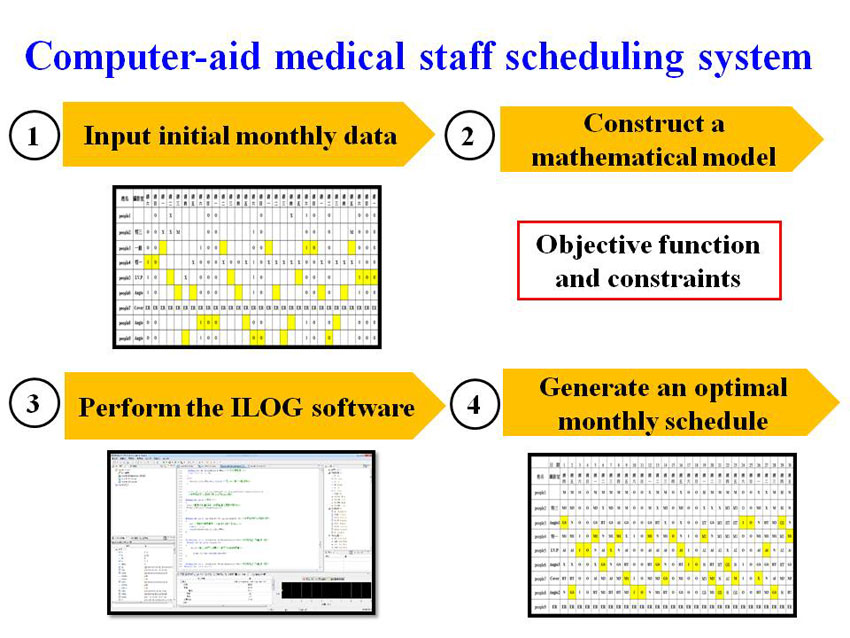Significance Statement
Researchers led by Professor Ping-Shun Chen from Department of Industrial and Systems Engineering at Chung Yang Christian University in Taiwan designed a two-stage method combining the worst-case scenario approach, goal programming, analytic hierarchy process AHP and branch-and-bound method to resolve integrated staff allocation and scheduling problems. The study was published in journal, Computers and Industrial Engineering.
Previous research has shown that heavy workload and longer workdays due to shortage of medical staff can lead to malpractice lawsuits and high turnover. Hence, appropriate allocation of medical staff needs to be put into consideration.
Three issues are involved when allocating medical staff; hospital staff policy, staff allocation and scheduling. Hospital staff policy and staff allocation issues are mostly considered by hospitals when creating a new department on when reallocation occurs. The departmental chair or team leader has the sole responsibility of staff scheduling which may take time to create due to uncertainties in staff preference and schedule compliance with government regulations and hospital policies.
A designed tool for staff schedule would be beneficial to team leaders or departmental chairs as their efficiency would increase.
For this research considering medical staff allocation problems MSA, demand uncertainties such as patients demands, medical processing time and availability of medical staff were determined by historical date of patients (August 2014 to May 2015), estimations based on worst-case approach and subtraction of scheduled days off from their working days respectively.
The worst-case scenario approach determined the smallest number of required medical staff for a medical team or a department as an initial size of medical staff for its scheduling problems.
After analytic hierarchy problems method determined and calculated medical staff required and weights of violating medical staffs preferences respectively, mineral weights of an unsatisfied medical staff schedule containing weight Wi calculated analytic hierarchy process method and penalties Pi caused by violating soft constraints I was determined which was subject to variables such as hard constraints of government regulations and hospital policies, soft constraints of medical staff’s preference and associated penalties with nonnegative and integer constraints of decision variables.
For implementation of a two-stage method in solving integrated staff allocation and scheduling problems, the first stage had four steps including gathering of relevant data through interviews with medical staffs, usage of worst-case approach to formulate the medical staff allocation problems based on demand uncertainty, calculation of minimum medical staff required based on branch-and-bound algorithm by CPLEX and definition of medical staff based on number calculated.
The second-stage involved the fifth step with distribution of questionnaires to medical staff in order to calculate weights of penalties associated with violating soft constraints using analytic hierarchy process method. Step 6 for construction of medical staff scheduling problem based on number of medical staff, step 7 for usage of branch-and-bound algorithm by CPLEX to solve medical staff scheduling problems, step 8 for checking of stop criteria in case of infeasible solution and the if the stop criteria is met, determination of optimal schedule with minimal objective value proceeds.
Results based in case hospital study having 1335 beds and 2500 employees with radiological technology schedule for emergency room ER with supports from departments such as computed tomography, portable and x-ray showed that among patients, only computed tomography patients had large standard deviations leading to large coefficient of variation. Percent of three classes (>15min, [10, 15]min and <10min) for computed tomography patient processing time is 25%, 25% and 50% respectively while portable and x-ray patients had 1%, 7% and 92% respectively indicating that computed tomography patients processing time is more uncertain.
Researchers identified 12 key factors (P1-P12) with top three key factors showing “Each radiological technologists should avoid ‘N-R-D’ working patterns “(P-9), “Each radiological technologists should avoid ‘R-S-R’ working patterns “ (P-7) and “Each radiological technologist should avoid ‘R-N-R’ working patterns” (P-6) with corresponding weights of 0.25, 0.15 and 0.13 respectively.
Further results showed key factors P-1, P-2, P-3 for “Each radiological technologies should avoid working a day shift followed by an evening shift. The next day avoid working a shift followed by a night shift the next day had more weight to factors of preferred day-off patterns compared to preferred working-shift patterns.
Results from branch-and-bound algorithm by CPLEX to solve medical staff scheduling problems showed recommended number of radiological technologies required in August 2014 was 17 with an optimal value of 0.12. The number was 17 from August 2014 to November 2014, 17 also from January 2015 to February 2015 and 18 from March 2015 to May 2015. The full factorial design of experiment using analysis of variance ANOVA further validated the proposed two-stage method was capable of solving the integrated staff allocation and scheduling problems.
This proposed method would definitely aid staff managers in assigning different medical staff to each department for scheduling planning period in order to overcome the uncertainty of both patient issues and medical staff issues.

Journal Reference
Department of Industrial and Systems Engineering, Chung Yuan Christian University, Chung Li District, Taoyuan City 320, Taiwan, ROC.
Go To Computers & Industrial Engineering
 Advances in Engineering Advances in Engineering features breaking research judged by Advances in Engineering advisory team to be of key importance in the Engineering field. Papers are selected from over 10,000 published each week from most peer reviewed journals.
Advances in Engineering Advances in Engineering features breaking research judged by Advances in Engineering advisory team to be of key importance in the Engineering field. Papers are selected from over 10,000 published each week from most peer reviewed journals.




